
Syrians bury the bodies of victims of a a suspected toxic gas attack in Khan Sheikhun, a nearby rebel-held town in Syrias northwestern Idlib province, on April 5, 2017. (Getty)
The chemical weapons attack in Khan Sheikhoun in the rebel-controlled Idlib area of Syria has horrified the world. (Warning: Some of the photos in this article are graphic.)
It was also the pretext given by President Donald Trump for launching missiles to destroy a Syrian airfield. The American president says that airfield was used to stage the earlier gas attack that killed men, women, and children.
On April 8, apparently undeterred, the Syrian government launched another attack on Khan Sheikhoun (sometimes called Shikhun), in Idlib province. The regime of Syrian dictator Bashar al-Assad and his Russia allies claim they are bombing ISIS and other terrorists; the U.S. accuses Syria of using ISIS as a cover to brutally clamp down on anti-Assad rebels in the Syrian Civil War.
What’s really going on in Idlib? What is Idlib and where is it located? Is ISIS there? What happened in the chemical gas attack? Is Syria bombing ISIS?
Here’s what you need to know:
1. The Poison Gas Smelled Like ‘Rotten Eggs’ as it Wafted Through the Town, Killing Small Children
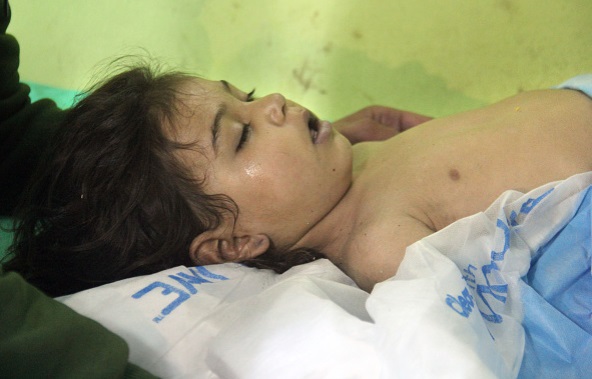
An unconscious Syrian child receives treatment at a hospital in Khan Sheikhun, a rebel-held town in the northwestern Syrian Idlib province, following a suspected toxic gas attack on April 4, 2017. (Getty)
The stories coming out of Idlib – and the town of Khan Sheikhoun within it – are horrific and have outraged the world. Idlib (sometimes called Idleb) is a northern province in Syria.
According to Al-Jazeera, at least 86 people died and hundreds more were sickened, “including people foaming at the mouth” after the chemical weapons attack on April 4.
The UN is investigating the attack as a war crime, and many – including Trump – blame Assad. According to Al-Jazeera, Syria and its Russian ally deny responsibility. Al-Jazeera reports that Assad claims “the Syrian army had bombed a warehouse belonging to rebels that contained chemical weapons,” a claim the rebels deny.
Amnesty International has been gathering detailed accounts about what happened in Khan Sheikhoun.
A senior director of research for Amnesty International laid the blame at the feet of Syria and Russia, writing on the site’s website, “Security Council members, and in particular Russia and China, have displayed callous disregard for human life in Syria by repeatedly failing to pass resolutions that would allow for punitive measures to be taken against those committing war crimes and other serious violations in Syria.”
Amnesty argues the victims were likely poisoned by the nerve agent, Sarin, and many died while sleeping in their beds. According to the humanitarian organization, it has authenticated 25 videos of the attack, which show horrors, including people with pinpoint pupils, “twitching and jerking movements,” and trembling. “One piece of footage, which Amnesty International has corroborated with other available content, shows nine children lying lifeless in the back of a pick-up truck. The children, little girls and boys, are naked or partially dressed; they appear to have died in their bed,” reports the organization.
One of the most horrific images to circulate around the world showed a father cradling his two deceased twins. A nurse told the organization he heard a thump like something was dropped, and then patients started coming into the hospital. The nurse told Amnesty International, “The smell reached us here in the centre; it smelled like rotten food. We’ve received victims of chlorine attacks before – this was completely different. Victims had vomit from the nose and mouth, a dark yellow colour, sometimes turning to brown. Paralysis in respiratory functions – children were dying faster than adults because of this. We tried injections … but it just didn’t work. Victims were unable to swallow, they were unconscious, completely unresponsive.”
2. Trump Says the Airfield Was Used to Stage the Attack & Khan Sheikhoun Was Already Struck Again
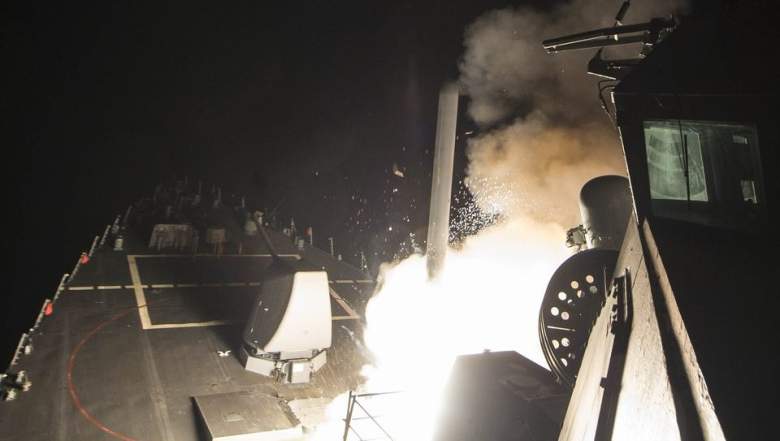
The Trump missile attack on Syria. (Twitter)
Trump struck the airfield with missiles in the wake of the chemical attack, saying the air base was used to stage the attack and describing how children had perished in it. No “child of God” should have to suffer such horrors, the American president said.
If the Trump air strikes were intended to get Syria to back off the people of Khan Sheikhoun in Idlib, that isn’t happening. It took the Syrians all of two days to regroup and hit the town again, CNN reports.
At least it appears that way. According to CNN, new airstrikes “targeted the town” on April 8, and only Syria and Russia conduct airstrikes in the region.
A woman was killed in a residential neighborhood and others were injured during the new strikes, reported CNN, adding that it wasn’t clear where they were launched from since the airfield was demolished by Trump’s missiles.
3. Idlib Was the Rebels’ ‘Final Stronghold’ in the Fight to Topple Assad
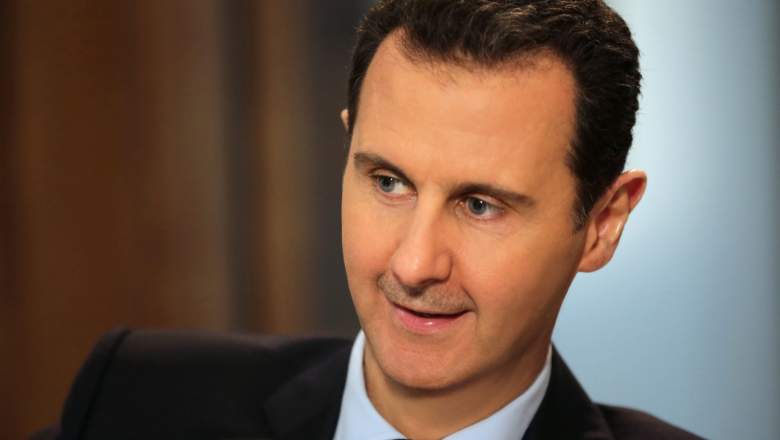
Syrian President Bashar al-Assad. (Getty)
Why Idlib? What’s the reason that Assad is focusing the tip of his spear there? It’s a rebel hotbed, and, in 2016, was regarded as the rebellion’s final stronghold against the Syrian leader.
In late December, the rebels lost Aleppo, which was regarded as a strategic prize, according to ABC News, because it was “the most densely populated and prosperous region under their control” and even a “de facto capital.” ABC News reports that the government took back Aleppo because, with the help of Russian air cover, it cut the supply link between Aleppo and Turkey and then hammered the city.
How does Idlib fit in? According to ABC News, Idlib is the neighboring province of Aleppo, and it’s the location where the rebel fighters and families were bused to after Aleppo was seized back by Assad. ABC News reported, “Idlib still has a strong supply line from neighboring Turkey but as a strategic base it is deeply compromised.” The network says it’s “home to a large displaced population” and is dominated by “two extremist groups.”
Which brings us back to the Syrian and Russian claims that Assad is bombing ISIS.
4. Both Extremist Groups & Moderate Rebels Fight in the Same Area
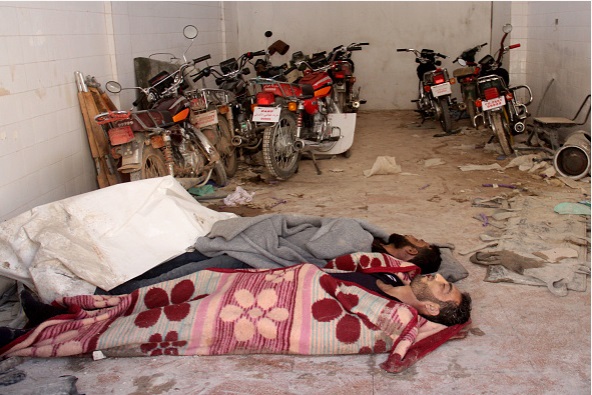
Bodies lie in the parking area of a hospital in Khan Sheikhun, a rebel-held town in the northwestern Syrian Idlib province, following a suspected toxic gas attack on April 4, 2017. (Getty)
So what’s the truth? Is Syria really bombing religious-focused terrorists? Or is it using that angle as a cover story to stifle the rebellion so the secular Assad can maintain control of the country?
According to ABC News, at least two extremist groups are active in Idlib: Ahrar al Sham and Jabhat Fateh al Sham (JFS), which was founded by Al-Qaeda. It gets really complicated. “More moderate rebels and the extremists” are “crammed now into just one major redoubt,” reported ABC News.
Ahrar al-Sham is also known as “Harakat Ahrar al-Sham al-Islamiyya, or the Islamic Movement of the Free Men of the Levant,” according to Stanford University.
Stanford describes the group as “a Sunni Salafist militant group operating in Syria that aims to replace the Assad Regime with an Islamic government.” The group was founded by men Assad had imprisoned but released during the Arab Spring.
According to Stanford, the group worked with ISIS until January 2014, when ISIS killed one of its fighters after its leader, Hassan Abboud “criticized IS commander Abu Bakr al-Baghdadi for rejecting reconciliation efforts between Syrian Sunni militant groups and classifying other jihadists as infidels.” In response, the organization pushed ISIS out of Raqqa. Stanford says it has pioneered the use of IEDs in Syria and targets military bases.
Jabhat Fateh al Sham cut its ties to Al-Qaeda in 2016, reported BBC.
According to BBC, “The former Nusra front was formed at the end of 2011, the result of al-Qaeda in Iraq’s leader (and now leader of so-called Islamic State (IS)) Abu Bakr al-Baghdadi ordering Abu Muhammed al-Julani to organise jihadist groups in the region.”
The group has claimed it was behind suicide bombings and rejected an overture to align with ISIS, choosing to align with Al-Qaeda instead, reported BBC. Idlib was its power base, according to BBC, which reports, “By the summer of 2015, the Nusra Front controlled most of Idlib province, including the capital, establishing Sharia courts and taking over government services.”
These two extremist groups, reports BBC, “were key to taking over Idlib from the Syrian government,” but they are mostly Syrian fighters, not foreign Jihadis.
5. Moderate Groups Are Also Operating in Idlib
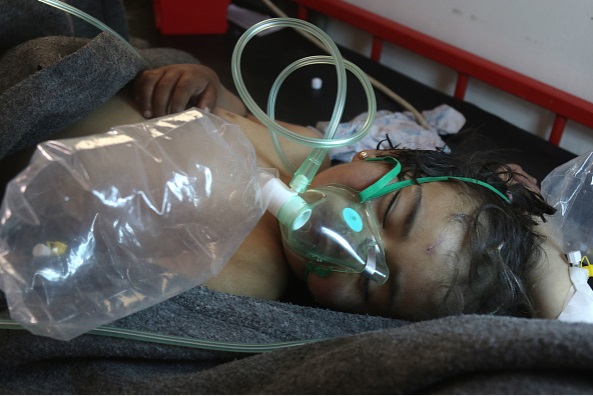
A Syrian child receives treatment at a small hospital in the town of Maaret al-Noman following a suspected toxic gas attack in Khan Sheikhun, a nearby rebel-held town in Syrias northwestern Idlib province, on April 4, 2017. (Getty)
The rebel groups do not all get along, according to Al-Jazeera. The news site reported that “six armed opposition factions in Syria” joined Ahrar al-Sham, “one of the country’s largest rebel groups.”
They did so after Jabhat Fateh al-Sham “attacked their positions in Idlib and Aleppo provinces,” reported Al-Jazeera.
Also in the mix: The Free Syrian Army. Hareetz reports that the The Free Syrian Army “began with a core group of senior officers who defected from the Syrian army and recruited thousands of soldiers and civilians.”
It was believed that the Army – affiliated with Turkey – could overthrow Assad but three years ago, the Free Syrian Army fractured into “six large militias, which are organized into brigades and battalions that operate in a number of areas in Syria without a central command,” reports Haaretz. The Free Syrian Army is helping Turkey fight ISIS, reports Haaretz.